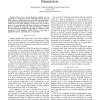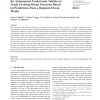44 search results - page 1 / 9 » Predicting Partial Paths from Planning Problem Parameters |
RSS
2007
13 years 6 months ago
2007
— Many robot motion planning problems can be described as a combination of motion through relatively sparsely filled regions of configuration space and motion through tighter p...
AAAI
1996
13 years 5 months ago
1996
In this paper we describe the design and implementation of the derivation replay framework, dersnlp+ebl (Derivational snlp+ebl), which is based within a partial order planner. der...
SARA
2009
Springer
13 years 11 months ago
2009
Springer
Classical planning deals with finding a (shortest) sequence of actions transferring the world from its initial state to a state satisfying the goal condition. Traditional planning...
IJRR
2010
13 years 3 months ago
2010
Path planning and trajectory design for autonomous underwater vehicles (AUVs) is of great importance to the oceanographic research community because automated data collection is b...
ATAL
2010
Springer
13 years 5 months ago
2010
Springer
A central problem in artificial intelligence is to choose actions to maximize reward in a partially observable, uncertain environment. To do so, we must learn an accurate model of ...


